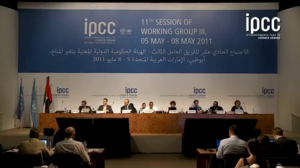UN: Renewable energies can meet world's power needs


The United Nations has found that renewable energy alone can meet global power needs - countering the burgeoning belief that nuclear power is the only viable solution.
Today, the United Nation’s Intergovernmental Panel on Climate Change (IPCC) released its Special Report on Renewable Energy Sources and Climate Change Mitigation (SRREN). The report painted a rosy future for renewable energy technologies.
IPCC’s working group of 120 researchers determined that nearly 80 percent of electricity could be generated through renewable sources by mid-century, eliminating between 220 to 560 Gigatonnes of carbon dioxide pollution by 2050.
This shift would hold the world’s temperature down two degrees Celsius, which meets the goal of the UN’s Cancun Agreements. The energy mix studied by IPCC includes forms of bioenergy, geothermal energy, hydropower, solar, and wind.
“With consistent climate and energy policy support, renewable energy sources can contribute substantially to human well-being by sustainably supplying energy and stabilizing the climate,” said professor Ottmar Edenhofer, the group’s current co-chair.
The report acknowledged political disagreement among developed economies vis-à-vis developing economies, and seeks to help policy makers understand that there are solutions for a collective way forward.
“What is unique about this assessment is that the IPCC allows us to draw on and bring together a broad spectrum of experts on each of the technologies reviewed in collaboration with scientists studying energy systems as a whole. It represents a systemic, broad, impartial and state of knowledge report on the present and future potential of a low carbon, more resource efficient energy path,” Edenhofer said.
Other key findings were:
- The energy potential of renewable technologies exceeds current global demand.
- Renewable energy capacity grew in 2009 across also categories in spite of the global economic downturn.
- Developing nations account for over 50 percent of the world’s current renewable energy capacity.
- Most reviewed scenarios showed that renewables would exceed the low carbon energy provided by nuclear power or fossil fuel power plants equipped with carbon capture technologies.
- There is no “one size fits all” policy for encouraging renewable power development.
- Some renewable power technologies can stand on their own today.
- Renewable energy solutions are not the only solution to reduce carbon emissions.
The IPCC working group also offered projection for different forms of renewable energy. See here There's also a brief video overview of the findings.
“What is unique about this assessment is that the IPCC allows us to draw on and bring together a broad spectrum of experts on each of the technologies reviewed in collaboration with scientists studying energy systems as a whole. It represents a systemic, broad, impartial and state of knowledge report on the present and future potential of a low carbon, more resource efficient energy path,” Edenhofer said.
The report stands in contrast to recent comments made by public figures such as Microsoft CEO Bill Gates who endorsed nuclear power at a conference in New York last week. Gates dismissed renewable technologies as “cute,” but unable to meet energy demands.
Gates noted that there is a lot of room for innovation in nuclear reactor designs. “The room to do things differently is quite dramatic,” he said. Gates is not a disinterested party: He has invested in nuclear power company TerraPower.
This post was originally published on Smartplanet.com